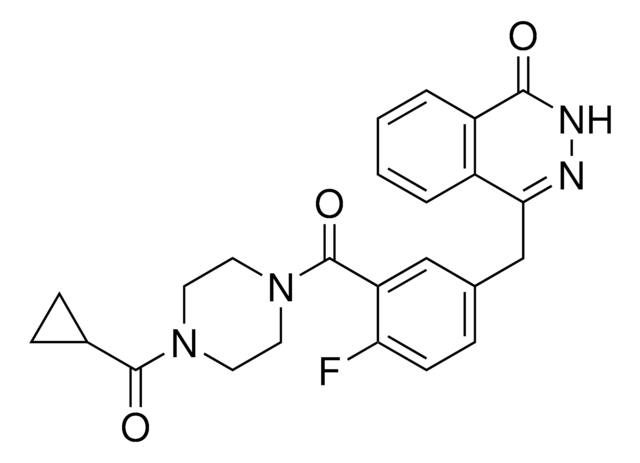528150
PARP Inhibitor VIII, PJ34
The PARP Inhibitor VIII, PJ34, also referenced under CAS 344458-15-7, controls the biological activity of PARP. This small molecule/inhibitor is primarily used for Cell Structure applications.
Synonim(y):
PARP Inhibitor VIII, PJ34
About This Item
Polecane produkty
Poziom jakości
Próba
≥98% (HPLC)
Postać
solid
producent / nazwa handlowa
Calbiochem®
warunki przechowywania
OK to freeze
desiccated (hygroscopic)
protect from light
kolor
white
rozpuszczalność
water: 5 mg/mL
Warunki transportu
ambient
temp. przechowywania
−20°C
InChI
1S/C17H17N3O2.ClH/c1-20(2)10-16(21)18-11-7-8-15-14(9-11)12-5-3-4-6-13(12)17(22)19-15;/h3-9H,10H2,1-2H3,(H,18,21)(H,19,22);1H
Klucz InChI
RURAZZMDMNRXMI-UHFFFAOYSA-N
Opis ogólny
Działania biochem./fizjol.
PARP
Opakowanie
Ostrzeżenie
Rekonstytucja
Inne uwagi
Garcia-Soriano, F.G., et al. 2001. Nature Med. 7, 108.
Mabley, G.J., et al. 2001. Inflamm. Res.50, 561.
Informacje prawne
Kod klasy składowania
11 - Combustible Solids
Klasa zagrożenia wodnego (WGK)
WGK 3
Temperatura zapłonu (°F)
Not applicable
Temperatura zapłonu (°C)
Not applicable
Certyfikaty analizy (CoA)
Poszukaj Certyfikaty analizy (CoA), wpisując numer partii/serii produktów. Numery serii i partii można znaleźć na etykiecie produktu po słowach „seria” lub „partia”.
Masz już ten produkt?
Dokumenty związane z niedawno zakupionymi produktami zostały zamieszczone w Bibliotece dokumentów.
Klienci oglądali również te produkty
Nasz zespół naukowców ma doświadczenie we wszystkich obszarach badań, w tym w naukach przyrodniczych, materiałoznawstwie, syntezie chemicznej, chromatografii, analityce i wielu innych dziedzinach.
Skontaktuj się z zespołem ds. pomocy technicznej










